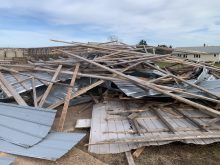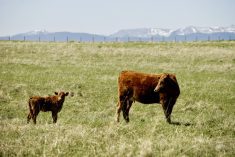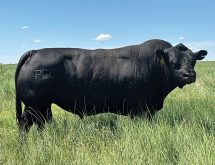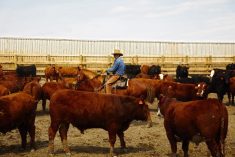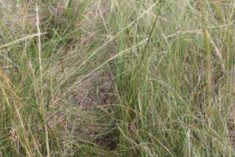In a previous article, I asked, Profitable Ranching — Is it Possible? I answered, “Yes, if you know how.” In two recent articles, I presented the five essentials for successful ranch management, which I believe are the essential attitudes, approaches or mindset you need to be profitable:
- The approach must be both integrative and holistic.
- Strive for continuous improvement of the key resources — land, livestock and people.
- Acquire and use good planning and decision-making tools.
- Wage war on costs.
- Emphasize marketing.
You can find those articles in the May and June 2023 issues of Canadian Cattlemen.
Now I want to discuss major determinants of profit.
There may be a few other essentials for your unique operation — especially if you have livestock other than cattle. Having watched many ranchers operate (and as I operated early in my ranching career), I found most of us placed way too much emphasis on weaning weight. It often took our attention away from other leverage points that have a lot more potential for improving profit. Increases in weaning weight always come with a cost.
Read Also

Canadian Beef Check-Off Agency reports on investments and activities
The check-off agency’s work behind the scenes is what ensures cattle check-off dollars are invested wisely, accounted for transparently and deliver measurable value back to producers and importers.
I won’t say that, in some cases, the costs aren’t justified. However, often they are not. The costs are not just the obvious increases in feed or supplementation. There is also a very significant cost when the weaning weight comes because you are running bigger cows that give more milk. Those bigger cows are usually less fertile than smaller cows weaning slightly smaller calves, and you could run more of the smaller ones on the same feed resource.
So, let’s look at some “big hitters.”
Enterprise mix and choices
How you choose to use your land and the profit centers that you put on it are extremely important. There is no one-size-fits-all solution. Each farm or ranch needs to make the best decision for its unique set of circumstances — ranch size, climate, topography, markets, personal lifestyle and quality of life goals, profitability goals (remembering that, if it’s not profitable, it won’t last long), etc.
Perhaps you should consider whether sheep or goats or even pastured poultry could fit into your operation and produce a very good revenue stream while adding significantly to soil health.
If you are firmly set on cattle only, then consider what your cattle operation should comprise.
If cow-calf, for best profitability, should you be a maternal breeder and develop your own replacement heifers? Or, should you produce terminal calves, sell all the calves and buy replacement cows? Or should you be a stocker operator?
I only want to be a little bit sarcastic when I suggest if you live in an area where you feed cows five months of the year, having cows isn’t very smart. Stockers in season would be much better. Areas that have that much snow usually have high-quality stocker grazing. Perhaps some combination of cow-calf and yearling operation should be considered.
I can further suggest that most ranchers would be significantly more profitable running a terminal operation rather than a maternal operation. Trust me on this. I have done the arithmetic many times and have managed both maternal and terminal ranches — different ranches under the same ownership. The only way the maternal ranches could compete from a profitability standpoint was if the maternal ranches could inexpensively develop replacement heifers in volume and sell bred cows (not bred heifers) at a premium price to terminal breeders. Then the two ranches would come out about the same. The main reason for the big terminal advantage is that every cow has the possibility of having a calf to sell. In the maternal herd, none of the yearlings will produce a calf to sell. Yet, they are still eating feed.
Overheads
Overheads are necessary for the running of a ranch business. They include:
- People and the tools and equipment needed to make their work efficient and effective.
- The land and structures attached to the land.
- The maintenance of tools, equipment and structures.
If your management will cause both your land value and people’s productivity to increase, that is very positive. But you need to be very careful with overheads that rust, rot or depreciate. If you don’t need them, you should get rid of them. These decisions are usually much easier to make intellectually than emotionally.
We get attached to stuff. The fastest turn-arounds in ranch profitability that I have seen have occurred when the rancher bites the bullet and gets rid of unnecessary overheads. Sometimes producers had to quit haying or change the calving season to better weather or take other drastic measures to achieve the reduction.
Stocking rate
Cow size and milk production have a big effect on stocking rate, which is a huge determinant to profitability. If you can run more cows on the same land, you will be more profitable. If your ranch will provide enough feed for 100 cows each weighing 1,400 lbs., the same feed will also be nearly enough for 140 cows each weighing 1,000 lbs. The smaller cows will wean smaller calves, but the calves won’t be proportionally smaller compared to the dams’ size. So, with smaller cows, you will wean significantly more pounds of calf per acre of land, and you will sell those lighter calves for more dollars per pound.
The whole ranch effect of more pounds of calf selling for more per pound makes a very significant difference in profit.
Grazing and pasture management
Grazing and pasture management are where the dollars really start to change.
I know several ranchers who have doubled and a few who have tripled their carrying capacity by using good soil health and regenerative practices. In the meantime, they did not have to add an employee, a tractor, a pickup or four-wheeler, or a saddle horse. The only thing they had to add was more help on the days they worked cattle — branding, shipping, preg checking, etc. — because of the increased number of cattle being worked.
One rancher told me he spent about $50 per acre on stock water development and fencing to make the grazing management work. That enabled him to reduce the acres required per cow-calf pair from 30 to 16 and reduce winter feeding in the meantime. Think of the economic power in that equation.

Fed feed versus grazed feed
Any time you place a machine or piece of equipment between the mouth of a cow and her feed source, it has just cost you money — especially with the ever-increasing cost of tractors, equipment and fuel. I won’t say there aren’t times when that cost is justified, because sometimes it is, but we too often let habit and custom justify it rather than a true need.
On the ranches I managed from 1990 to 2010, we didn’t own haying equipment. We sold it to remove the temptation to put up more hay than we needed for emergencies — the occasional deep snow conditions, which did happen.
We quit haying thousands of acres of irrigated meadows and began to pasture them. We greatly reduced the amount of hay produced on sub-irrigated meadows and pastured them more. I challenge you to reduce the number of days when you feed, and increase the number of days you ask your cows to graze with perhaps a little protein supplementation. Have a contingency plan because you will need it, but don’t miss out on all the opportunities Mother Nature gives you to be more profitable and let the cows do the work they were designed to do. This is another huge profit changer.
Calving season
The selection of a calving season is far more important to profitability than most of us recognize. Think of this — the minute a cow calves, her requirement for nutrients nearly doubles.
If you are calving in winter, how do you make that happen cost-effectively? If you are calving in late spring or early summer, nature can provide those nutrients at a much more affordable cost. What happens to the need for calving barns, other facilities and labour when you calve in sync with nature?
I think cows were designed to lose a little weight in the winter and then gain it back in late spring and summer — even with a young calf at side. I think each ranch needs to pick its own “best” calving time. I like it to be after the risk of winter-type storms is very minimal and the breeding season will happen before the grasses begin to deteriorate in the fall.
It is not reasonable to ask cows to graze through most of the winter when the feed quality is not so good and there is snow on the ground and then calve in February and March. That just won’t work. However, they can start calving in late April or May and gain body condition rapidly after calving and easily rebreed in late July or August.
Realized herd fertility
In a perfect ranching world, every cow would get pregnant in the first cycle of the breeding season, carry the calf successfully to a live birth, wean the calf and then each calf would live until it’s sold as a calf, yearling, bred yearling, bred cow or cull cow. That will never happen.
But, the closer we come to not using a lot of expensive inputs and instead depend on Mother Nature, adapted cattle, good grazing management and good animal-handling procedures, the more profitable we will be. Fertility and survivability are highly dependent on having cattle that are adapted (see the October 2021 issue).
Wise input use for optimum production
Except for some marketing costs, almost all non-overhead inputs in our cattle operations are wormers, insecticides, immunizations, medicines and feeds, including salt and mineral. While I’m not part of the “no-input” crowd, I am certainly a strong advocate of “low-input” cattle production. I firmly believe when we select cattle that are adapted to our respective environments and our calving season is correct, Mother Nature provides most of what our animals need. I think we need to take the rough edges off what nature throws at us — terrible weather, drought, diseases from neighbours’ herds, etc.
I long ago quit using wormers and insecticides and haven’t felt a loss for not using them. I have greatly reduced the number of immunizations, but still think we need some insurance against things that can come from other herds one way or another. When it comes to feed and supplements, we need to meet basic energy and protein needs.
With good grazing management, we should be able to do that most of the time; but we need to fill the gaps in the event of terrible weather situations. When it comes to feed additives, special minerals, etc., I want to feel like I will get at least two dollars back for every dollar spent. Why, you might ask? Because neither our ability nor the ability of the salesperson to predict the advantage is perfect. If the cost of the product should double and I can no longer afford it, what will be the effect on the herd when it is not there for them?
I think we must be very careful when buying those kinds of inputs. And, we need to carefully evaluate protein supplements even when we intend to buy them.
Marketing
Marketing could have more economic potential for individual ranches than anything in this article except for stocking rate or enterprise selection. Most of us need to devote more time to marketing. See the August 2022 issue of this magazine for more on marketing.
– Burke Teichert is a longtime manager of large ranches. He is also a consultant and speaker. Contact him at [email protected].



